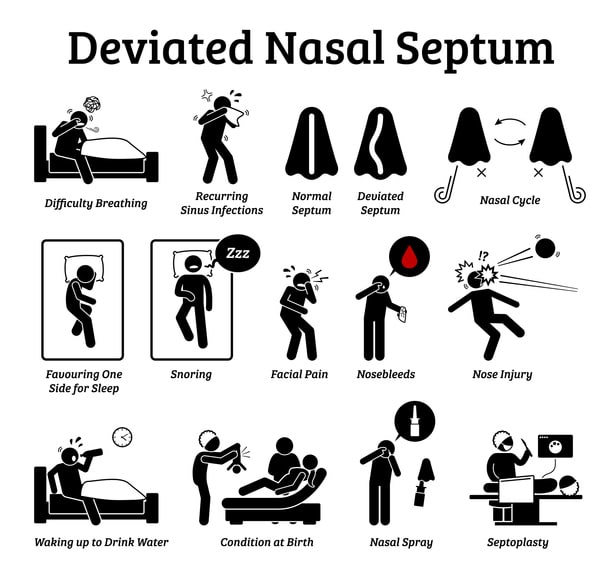Our noses are one of the most important organs we have. They are designed to filter and warm the air we breathe. The nasal septum runs down the middle of the nose, dividing the bone and cartilage into two compartments. If the septum is deviated, it can dramatically impact the nose’s function. Septal Deviation can be caused by genetics or trauma. Our physicians at the St. Louis Sinus Center are fully equipped to treat a deviated septum in St. Louis, MO.
What Is The Nasal Septum?
The nasal septum is a thin wall that separates your right and left nasal cavities. Ideally, it is situated in the center of your nose. However, it is estimated that 80 percent of all nasal septum’s are off-center making one nasal passage smaller. This may make it hard to breathe or impair nasal drainage.

Symptoms Of A Deviated Septum
Those with mild to moderate deviations may not experience any symptoms, while patients with severe septal deviation may have difficulties breathing through the nose – one of the most common symptoms. Other symptoms may include:
- Blockage of one or both nostrils causing reduced airflow
- Nasal congestion, sometimes only on one-side
- Nosebleeds
- Frequent sinus infections
- Facial pain
- Headaches
- Postnasal drip
- Snoring or difficulty breathing at night

What Causes Septal Deviation?
Septal deviations are usually the result of nasal trauma, but in some cases, it is just the way the patient’s nose developed during his or her childhood.
How Is A Deviated Septum Diagnosed?
Septal deviations can be diagnosed in one of three ways. The first will detect deviations in the front of the nose, while the second and third can detect deviations further back in the nasal passages.

- Step 1 – Examination: A simple examination will detect deviations that may be in front of the nose.
- Step 2 – Nasal Endoscopy: A nasal endoscopy is performed in the office by sliding a tiny camera mounted on a slender telescope and passing it through the nostrils. This procedure is well tolerated, and although some patients may prefer a numbing nasal spray prior to the procedure, generally an endoscopy can be completed with no special medications at all.
- Step 3 – MiniCAT Instant CT Scanner: The MiniCAT Instant CT scanner creates high-quality images of the sinuses in 20 – 40 seconds while the patient sits upright comfortably in an open chair. The low-dose CT uses only 10% of the radiation dose used typically with CT scanners, and the procedure can be performed in the office.
What Are My Treatment Options For A Deviated Septum?
Medications and treatments will not cure a deviated septum but can help ease symptoms caused by a septal deviation.

- Allergy Treatment – if allergies are exacerbating the deviation, then patients may benefit from allergy treatment. Treating allergies will decrease the swelling of the lining of the septum and surrounding tissue. Patients will notice less congestion, but it is important to keep in mind that this will not alter or fix the septal deviation.
- Medications – can be used to ease symptoms. Some options include:
- Decongestants
- Antihistamines
- Nasal Steroids Spray
- Nasal Antihistamine Sprays
- Allergy Immunotherapy (shots or drops)
What Is A Septoplasty?
For patients with severe septal deviations, medications are usually less effective and the patient may ultimately require surgery. A septoplasty or septal reconstruction is a procedure meant to straighten the deviated cartilage within the septum. Septoplasty is an outpatient procedure and takes approximately 25 – 45 minutes.

Septoplasty is performed entirely through the nose, and leaves no external scars or bruising after the surgery.
Needing a septoplasty is a question of function. Dr. Gould uses a scope to check the deeper tissues of the nose to evaluate airflow. Minor deviation of the septum may not merit correction, but problematic deviation will reduce airflow. This can impact normal breathing (creating more mouth breathing) and sleep. Plus, the additional exposure of a deviated septum to the drying effect of airflow through the nose can make that side of the nose crust and prone to bleeding. Septoplasty can repair the septum and return normal airflow.
What are the Benefits of Having a Septoplasty?
Having some degree of deviation in the septum isn’t all that rare, but for most people, it doesn’t really impede airflow. However, if your deviation is severe, it can block one side of your nose and decreases your breathing capacity. This can create mouth breathing, snoring, and/or decreased airflow of sleep apnea while sleeping.
A septoplasty straightens and corrects the position of the septum to return normal, effective airflow through the nostrils. Dr. Gould’s patients are very satisfied with the improvements in their breathing and decreased nasal congestion gained through septoplasty.
Who is a Candidate for Septoplasty?
Damage to the septum is either congenital or from trauma. When the septum is damaged or malformed during pregnancy, it can happen when the baby is passing through the birth canal. Traumatic damage may be from a car wreck, singular sports injury, or even from repeated contact from sports such as wrestling. Over time the septum becomes displaced.
How is Septoplasty Performed?
For this surgery, Dr. Gould makes any necessary incisions within the inside of the nose. The first step is to lift the mucus membrane that covers the septum. He then straightens the nasal septum by trimming, repositioning, and sometimes replacing cartilage or bone. He may need to make a small incision between the nostrils. If the bones are crooked, he may make cuts in the bones before repositioning them. If there is a problem with a depressed bridge, spreader grafts (small reinforcing strips of cartilage) can be used to build it up. When the necessary changes have been made, the mucus membrane is returned and repositioned, and the incision is closed. Silicone splints are placed in each nostril for support during healing and are removed in a week.
What Will Recovery Be Like After Septoplasty?
Post-surgery you will want to rest and avoid anything coming in contact with your nose. Wearing button-down shirts or blouses may be helpful, as it’s easy to brush your nose. You’ll have some minor pain and swelling for a day or two but swelling with this surgery doesn’t linger (unlike cosmetic nose surgery).
For postoperative prophylaxis, the antibacterial drug is often prescribed at a dosage of 500 mg to prevent infections at the site of the surgery.

Silicone splints will provide support inside your nostrils. You’ll need to sleep with your head elevated for a few days. You will receive detailed care and recovery instructions and our nursing team is always a call away to answer any question along the way.
What Will My Results Look Like From Septoplasty?
Patients usually notice a significant improvement in their breathing after surgery. Symptoms such as snoring, chronic nosebleeds, and headaches are significantly reduced.
What are the Risks With Septoplasty?
Because there is minimal tissue trauma with this procedure, complications are rare. The training and extensive experience of Dr. Gould, as a board-certified otolaryngologist, plays a role in the minimal risk with these surgeries.
Continued bleeding is possible. The septum can be perforated. Your sense of smell can be decreased, although this is unusual. The main risk is that the procedure doesn’t improve your breathing to the degree you had hoped. If this is the case, some patients may opt for a revision septoplasty for further refinement.
Is Septoplasty Covered by Insurance?
These procedures are typically covered by insurance providers. That’s because a deviated septum can cause serious problems, including chronic sinusitis and sleep apnea. These are considered to be medically necessary procedures.
Schedule A Consultation
If you’re interested in learning more about septal deviation and how we treat it, please call 314-450-7720 to schedule a consultation with our experienced team at our offices in St. Louis and Festus, MO. You can change your life with nose surgery and you can take the first step by speaking with us.

